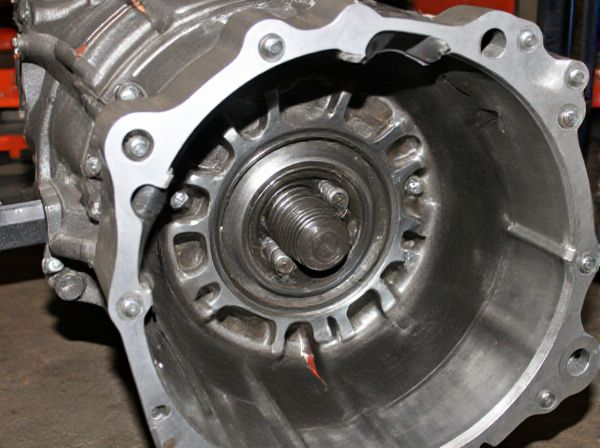
Photo illustration: Transaxle vs Transmission
A transaxle combines the functions of the transmission, differential, and drive axle into a single integrated unit, often found in front-wheel-drive vehicles for improved space efficiency. The traditional transmission is a separate component responsible solely for gear shifting and power transfer from the engine to the drive shaft. Your choice between the two depends on the vehicle layout, with transaxles offering compact design benefits and transmissions providing more flexibility in rear-wheel or all-wheel-drive configurations.
Table of Comparison
| Feature | Transaxle | Transmission |
|---|---|---|
| Definition | Combined transmission, differential, and drive axle in one unit. | Mechanical device that transmits power from engine to wheels. |
| Common Use | Front-wheel drive and some rear-engine vehicles. | Rear-wheel drive and many front-wheel drive vehicles with separate units. |
| Components | Integrated gearbox and differential. | Gearbox alone; differential is separate. |
| Weight & Space | More compact and lighter overall. | Typically larger and heavier due to separate parts. |
| Maintenance | Can be more complex to service due to integration. | Generally easier to service individual components. |
| Performance Impact | Improves efficiency in front-wheel drive setups. | Offers flexibility for various drivetrain layouts. |
Introduction to Transaxle and Transmission
A transaxle integrates the transmission, differential, and drive axles into a single component primarily used in front-wheel-drive and rear-engine vehicles, optimizing space and weight. In contrast, a transmission is a standalone component that transfers engine power to the driveshaft, found in most rear-wheel-drive vehicles. Understanding the structural and functional differences between a transaxle and a transmission helps clarify their respective roles in vehicle drivetrains.
Key Differences Between Transaxle and Transmission
A transaxle integrates the transmission, differential, and drive axle into a single unit, primarily used in front-wheel-drive and some rear-engine vehicles to save space and reduce weight. A transmission, on the other hand, is a standalone gearbox that transmits engine power to the drive shaft and is commonly found in rear-wheel-drive configurations. Key differences include layout, component integration, and typical vehicle application, with transaxles combining multiple functions while transmissions focus solely on gear shifting.
Components of a Typical Transaxle
A typical transaxle integrates the transmission, differential, and driveshaft components into a single compact unit, commonly found in front-wheel-drive vehicles. Key elements include the input shaft, gear sets for various speed ratios, differential gears for power distribution to the wheels, and output shafts that connect directly to the drive wheels. This consolidation enhances efficiency, reduces weight, and improves space utilization compared to a separate transmission and differential system.
Components of a Traditional Transmission
Traditional transmissions consist of key components such as the clutch, gear sets, synchronizers, shift forks, and the output shaft, all housed within the transmission casing. The clutch engages and disengages power from the engine to the transmission, while synchronizers facilitate smooth gear changes by matching gear speeds. Gear sets determine the gear ratios, enabling the vehicle to optimize torque and speed across various driving conditions.
How Transaxles Work in Modern Vehicles
Transaxles combine the functions of the transmission and differential into a single integrated unit, commonly used in front-wheel-drive and all-wheel-drive vehicles. They work by transmitting engine power directly to the drive wheels while managing gear ratios to optimize speed and torque for efficient performance. Modern transaxles incorporate advanced electronic controls and lightweight materials to enhance fuel efficiency and reduce emissions.
Advantages of Using a Transaxle System
A transaxle system combines the transmission, axle, and differential into a single unit, reducing overall weight and improving vehicle efficiency. Its compact design allows improved packaging in front-wheel-drive and rear-engine vehicles, enhancing space utilization and vehicle handling. The integration also simplifies maintenance and can lead to lower production costs compared to separate transmission and axle systems.
Benefits of Standalone Transmissions
Standalone transmissions offer enhanced durability and easier maintenance compared to integrated transaxle systems, making them ideal for high-performance or heavy-duty vehicles. By separating the transmission from the differential, standalone units provide improved customization options for gear ratios and torque handling. This separation also enables more straightforward repairs and replacements, reducing downtime and overall service costs.
Common Applications: Transaxle vs Transmission
Transaxles are commonly applied in front-wheel-drive vehicles, combining the transmission, differential, and drive axles into a single integrated unit to save space and improve efficiency. Traditional transmissions are prevalent in rear-wheel-drive and four-wheel-drive vehicles, where the transmission and differential are separate components allowing for more robust power delivery and off-road capability. Transaxle systems optimize compact vehicle designs, while conventional transmissions support diverse applications requiring higher torque and durability.
Maintenance and Reliability Comparison
Transaxles integrate the transmission and differential into a single unit, commonly used in front-wheel-drive vehicles, requiring less frequent maintenance due to fewer moving parts exposed to wear. Traditional transmissions, typically separate from the differential, demand regular fluid changes and inspections to ensure reliability and prevent costly repairs. Reliability in transaxles often benefits from their compact design, while conventional transmissions may offer easier serviceability but require diligent upkeep to avoid performance issues.
Choosing the Right Option for Your Vehicle
Choosing the right option between a transaxle and a transmission depends on your vehicle's drivetrain layout and performance needs. Transaxles combine the transmission and differential into one compact unit, making them ideal for front-wheel-drive and some rear-engine cars, offering better weight distribution and efficiency. Traditional transmissions, paired with separate differentials, suit rear-wheel-drive vehicles and provide greater flexibility for performance tuning and maintenance.
 caratoz.com
caratoz.com